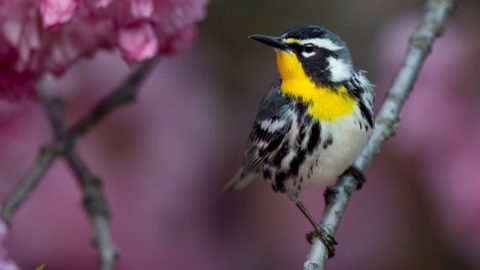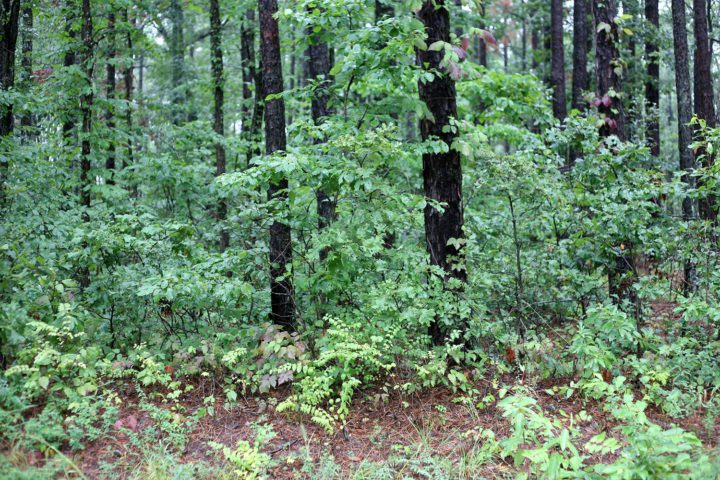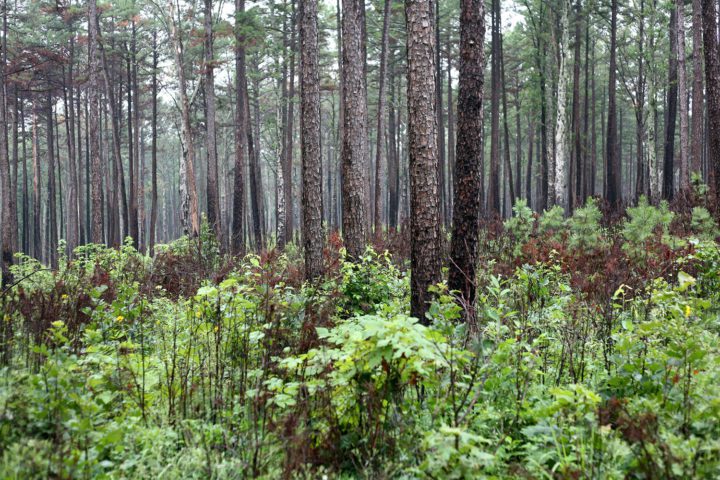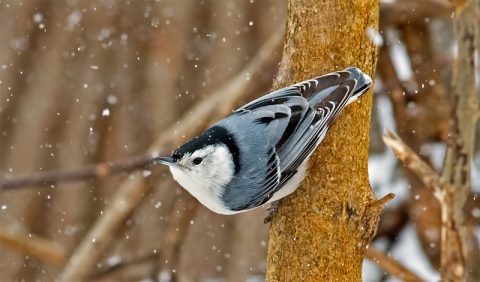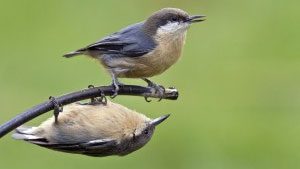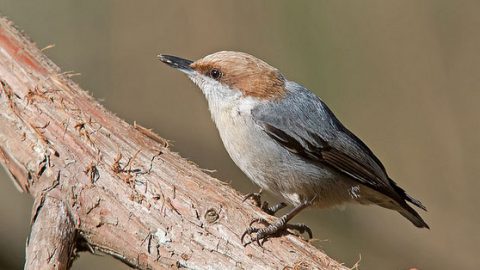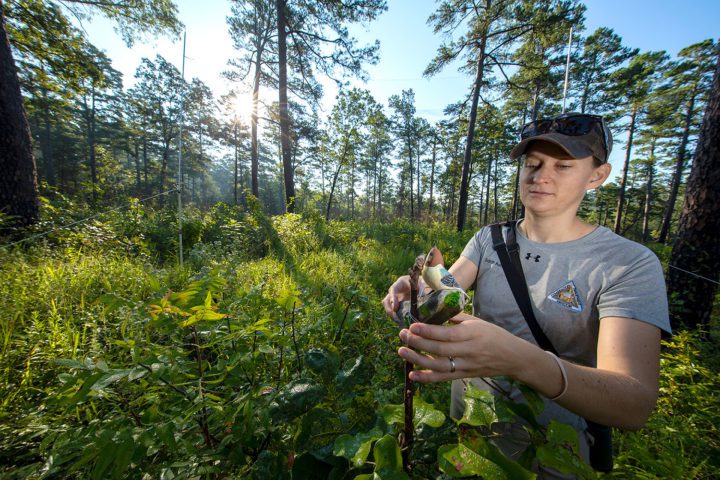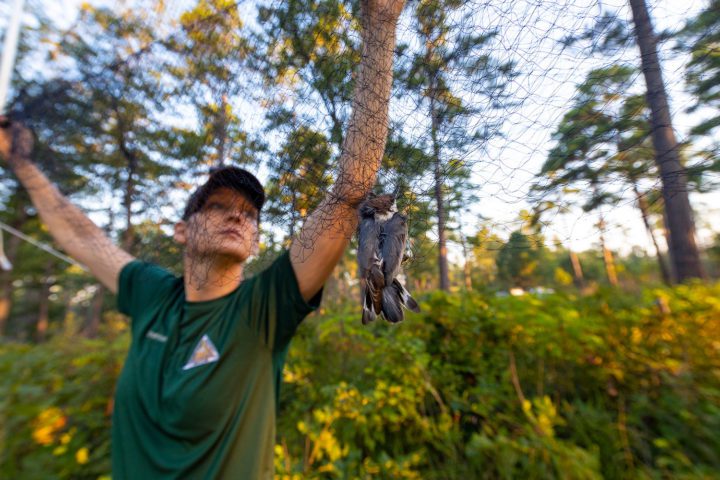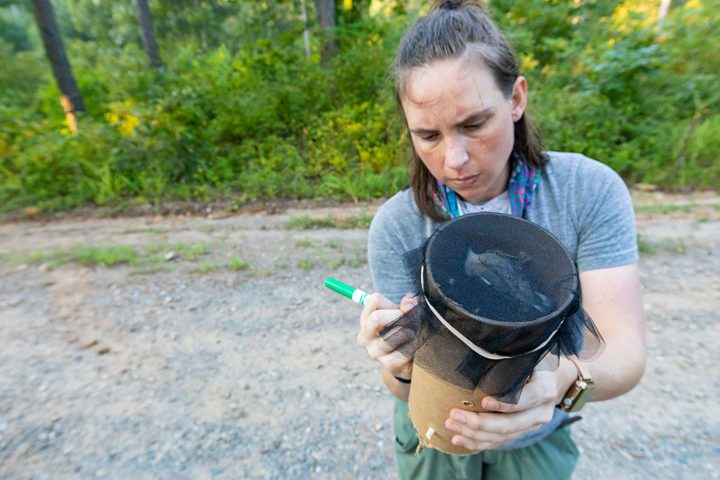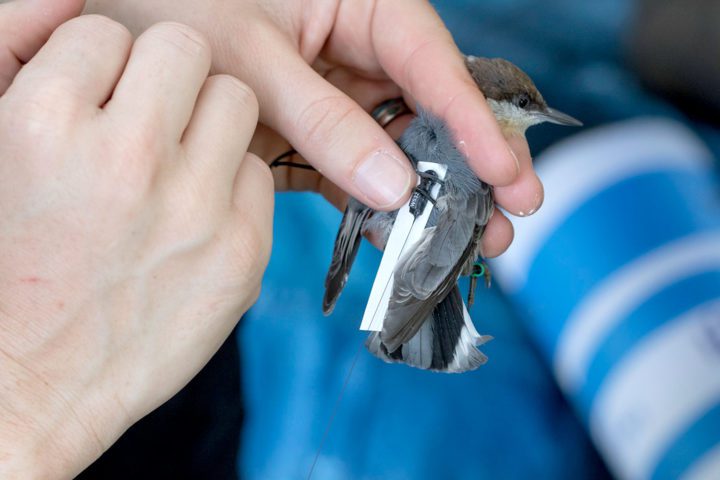Brown-headed Nuthatches Return to Missouri’s Ozark Mountains After 100 Years
By Greg Breining
Brown-headed Nuthatch by Noppadol Paothong/Missouri Department of Conservation. March 29, 2021Habitat restoration and prescribed fire have made the Ozarks hospitable to the squeaky nuthatches for the first time in a century. All they needed was a helping hand to get there.
From the Spring 2021 issue of Living Bird magazine. Subscribe now.
Late last summer, Sarah Kendrick and several other researchers hauled two plastic milk crates into a sunny shortleaf pine glade in Mark Twain National Forest in the hills of southeastern Missouri.
Kendrick, the state ornithologist with the Missouri Department of Conservation, pulled out a cardboard mailing tube and slipped her hand inside the netting on the end of the container to tease out a 4-inch songbird with a chocolate-brown cap and steely gray-blue back. Kendrick and her colleague Kristen Heath of the University of Missouri huddled over the bird to attach a radio transmitter weighing just a hundredth of an ounce, the weight of a large pea, with a small elastic harness for fitting on the bird’s back. Then they crimped identification bands around the bird’s legs.
Kendrick opened her hand and the tiny Brown-headed Nuthatch flitted to a nearby bough and issued its unmistakable rubber-ducky squeak—the first of its species in perhaps 80 years to call in the pine woodlands of the Missouri Ozarks.
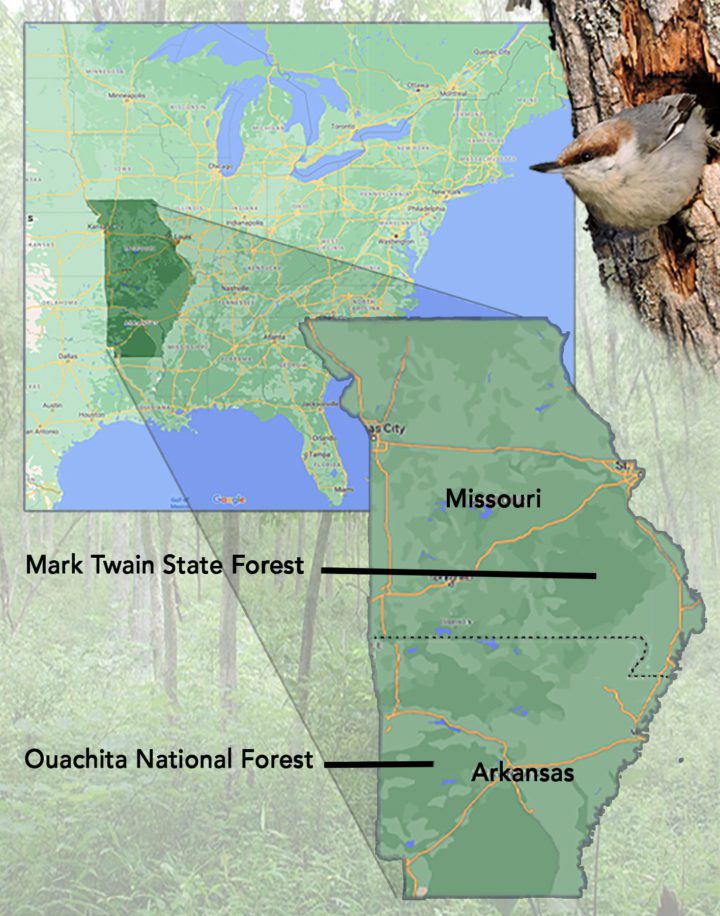
Last year’s reintroduction of 46 Brown-headed Nuthatches was made possible by a decade-long effort to restore the shortleaf pine woodlands of southern Missouri, work that paved the way for ornithologists and conservationists to reintroduce the long-gone native bird to the Ozarks. An additional 50 or so nuthatches will be relocated this summer, in hopes of establishing a breeding population.
So far the results are encouraging—no birds died during capture and release, and for several weeks at least, none had been picked off by predators.
“They’re just foraging away and acting like nuthatches,” says Kendrick. “I think it has resonated with so many conservation partners because it’s a feel-good conservation story. We’ve brought back the habitat, [and] we were able to bring back one of the birds that used to occur here.”
Woodland restoration has paid other dividends as well. Several other bird species that favor savanna, grassland, and open woods have flourished in these renovated woodlands, a restoration of the Ozark Highlands patchwork forest that once spread across southern Missouri. The successful reintroduction could also enable the future northward range expansion of the Brown-headed Nuthatch—boosting its chances for survival in a warming climate, thanks to a strategy known as assisted migration.

Land of Frequent Fire
Way back when, a mix of woodlands covered the hills of southern Missouri—closed-canopy forests in the creek bottoms and protected slopes, and parklike shortleaf pine woods with sunlight dappling a low herbaceous understory in less sheltered areas. Up on the high slopes and hilltops there was prairie and savanna with widely scattered trees.
Says Kendrick: “You hear of historic accounts where people would ride wagons through these woodlands. They were very open.”
But in the late 1800s and early 1900s, the railroads, loggers, and settlers came through, slicking off the pine and most everything else. Trees grew back during the 20th century into a wall of oak and hickory with a sun-blocking canopy. The 6 million acres of open pine woodland that covered Missouri in presettlement times largely disappeared.
“There literally were millions of acres of woodlands in the Ozark Highlands of Missouri, and it got reduced to essentially thousands of acres,” says Frank Thompson, a U.S. Forest Service Northern Research Station wildlife biologist who has been a key figure in the woodland restoration and nuthatch reintroduction.
The difference was fire. Long ago the landscape was thinned and groomed by blazes, some ignited by lightning but most set intentionally by Native Americans to create the openings where elk browsed, bison grazed, and turkeys scratched. Flames crept along the forest floor, sparing mature pines but killing competing brush and hardwoods. By contrast, modern humans, abetted by Smokey Bear, extinguished every wildfire they could.
“Humans have always been a part of that landscape and used fire extensively,” says Thompson. “It was that long-term history of frequent fire that sustained that ecosystem across that landscape.”
In the choked-out modern forest, there was no place for the once-abundant Brown-headed Nuthatch.
Seymour Woodruff, a New York forester with an interest in birds, noted the existence of Brown-headed Nuthatches during early 20th-century surveys, and in 1907 he collected a pair of these nuthatches in Black Valley in Shannon County (very near the recent release site). It was, apparently, the last published observation of the species in Missouri.
“There just weren’t a ton of ornithological surveys in the late 1800s, early 1900s, but there were records of [Brown-headed Nuthatches] existing here,” says Kendrick. “We can’t be exactly sure when the birds left.”
But by the mid-1900s, they had probably vanished.
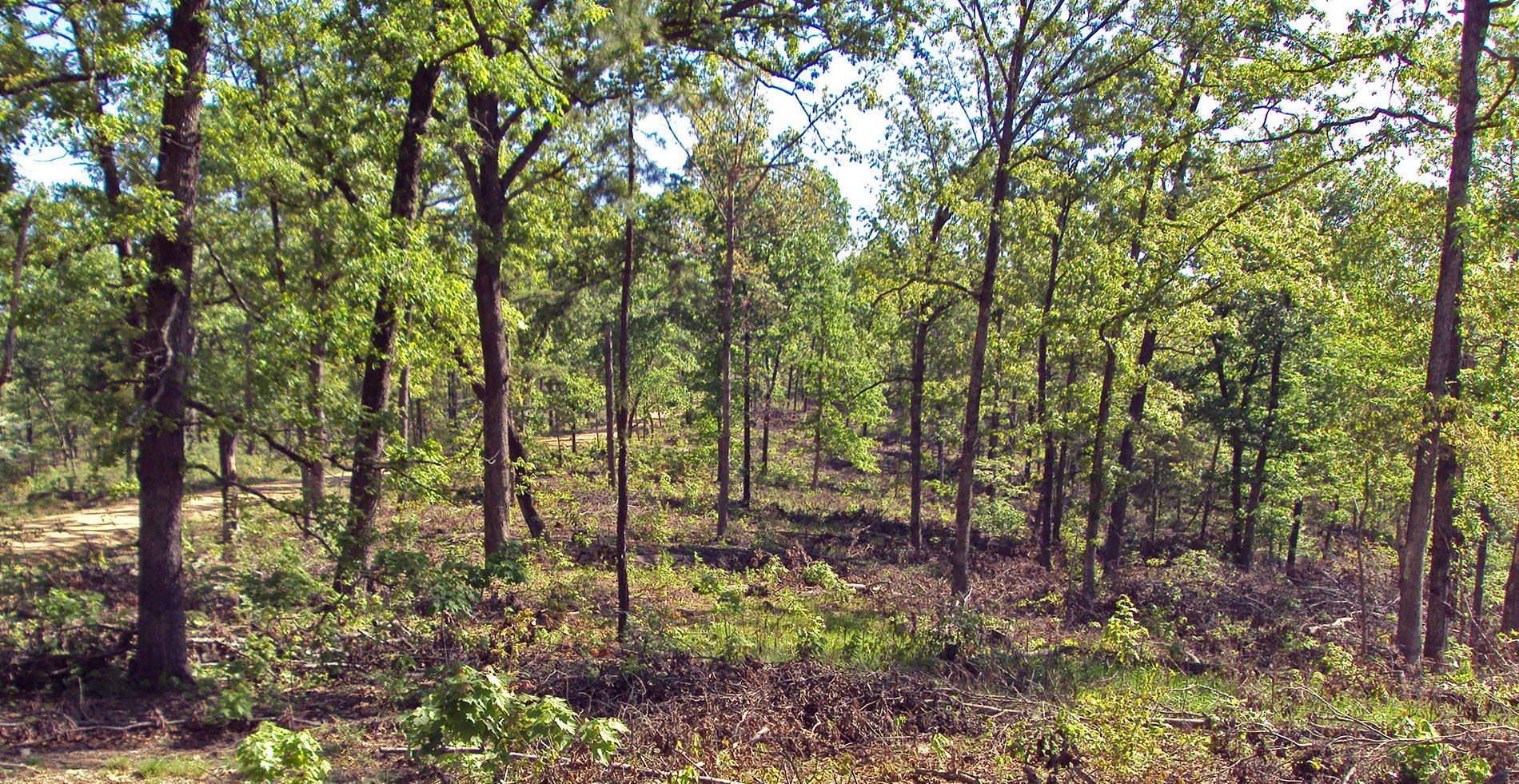
Restoration, and a Boost
Well aware of what had been lost, forest managers and wildlife researchers began restoring small blocks of Missouri woodland as early as the 1980s.
“With fire and thinning, these communities came back,” says Thompson. “Some of the seed bank had lasted, and the ground floor returned with fire.”
Restoration got a big boost in 2012 when the Mark Twain National Forest, scattered in several blocks across southern Missouri, won approval and $10 million from the federal Collaborative Forest Landscape Restoration Program. The CFLRP was created by an act of the U.S. Congress in 2009 to enhance forest and watershed health, reduce wildfire risks, and benefit rural economies through science-based forest management. Then more funding came from the Central Hardwoods Joint Venture—a partnership of the U.S. Forest Service, U.S. Fish and Wildlife Service, state agencies in Missouri and neighboring states, and nonprofit partners such as The Nature Conservancy and National Wild Turkey Federation. All those groups came together in the joint venture to work toward the long-term viability of native bird populations in the Central Hardwoods Bird Conservation Region.
According to Kendrick, “a lot of money” was mustered “into this intensive management to thin trees and use prescribed fire to maintain those woodland habitats.”
Restoring pine woodlands in the Ozarks begins with timber sales to local loggers to harvest trees and open up the canopy from nearly 100% closed to only 30% to 80% cover; the reduced canopy lets in some sunlight. Loggers sell the pine and red oak timber to local mills for everything from oak flooring to pallet material.
By sending work to loggers and wood products to local mills and retailers, the restoration program is “actually returning more on the dollar than it’s costing,” says Thompson. An economic study by the University of Missouri found the effort is expected to support an average of 138 jobs a year and generate $34 million in labor income, with $44 million added to the local nine-county economy during the life of the project.

Untreated woodlands in the Mark Twain National Forest. Photo by Oak Woodlands & Forests Fire Consortium/Creative Commons. 
Twenty years of prescribed fire in the same forest. Photo by Oak Woodlands & Forests Fire Consortium/Creative Commons.
Once loggers open the canopy, foresters begin systematically burning the sites during the winter to consume brush and tree sprouts. They may burn 1,000 acres at a time, with prescribed burns every three to five years to keep the understory open.
“Over time it will require less effort,” says Thompson. “This accelerated funding is not going to be there forever, so that is probably a good thing.”
After nine years, the results have been impressive. The Mark Twain National Forest has thinned and opened up 42,000 acres and burned about 104,200 acres, says Brian Davidson, botany and invasive species program manager for the forest. Thompson’s research documented population increases for 16 woodland bird species, including ground-and shrub-nesting birds such as Prairie, Kentucky, and Blue-winged Warbler, along with Yellow-breasted Chat, Bachman’s Sparrow, and Northern Bobwhite. Canopy-nesters, such as Pine Warbler, Red-headed Woodpecker, and Summer Tanager also benefited.
Says Thompson: “When we looked at nesting success [for these birds], many of those very same species were not only more abundant in the restored woodlands, but they also had higher nest success.”
But one bird species didn’t respond to the woodland restoration: the Brown-headed Nuthatch. Absolutely none showed up in the habitat that now appeared perfect for them.
The Brown-headed Nuthatch is similar in shape and tree-creeping behavior to the slightly larger White-breasted Nuthatch, but it’s much more limited in its range, living only in the southeastern United States. And it’s more specialized in its habitat preference, favoring open woodlands of mature loblolly, shortleaf, longleaf, and slash pine. Brown-headed Nuthatches eat bugs beneath the bark, sometimes even using a piece of tree bark to pry away flakes of bark to expose insects. They excavate nesting cavities in dead pine snags each year.
More on the Brown-headed Nuthatch
But the nuthatch is a nonmigratory, year-round resident, and not a particularly strong flier. And it is a cooperative-breeding species, meaning multiple birds may help with care and rearing of young in a nest. Their communal-breeding nature tends to keep Brown-headed Nuthatches close to their home range.
The Mark Twain National Forest sits just north of the species’ current range. The nearest large breeding population of nuthatches lives more than 200 miles south in Ouachita National Forest in Arkansas. It seemed no Brown-headed Nuthatches were willing to venture north to Missouri on their own, much to the dismay of scientists waiting expectantly for their arrival.
Among the disappointed lot were Kendrick, Thompson, Thomas Bonnot, an assistant research professor at the University of Missouri, and Jane Fitzgerald of the Central Hardwoods Joint Venture—all flabbergasted that the little brown-capped birds didn’t return to this perfect home for them.
“Instantly a couple members of the team said, ‘Well that’s just crazy. We’re not going to get nuthatches, even though we put this habitat here?’” says Bonnot.
That’s when the group began to talk about relocating nuthatches from Arkansas. Says Thompson, “We started to ask the question: Is it realistic to think about this?”
Thompson had a master’s student work in Arkansas to locate nuthatches and characterize the habitat where the birds spent most of their time. Bonnot, too, traveled to Arkansas to research nuthatch habitat use. He confirmed the key elements of ideal nuthatch habitat—predominantly pine, open canopy, open understory with herbaceous ground cover, and, especially important, an abundance of dead pine snags for nesting cavities.
Using satellite imagery, Bonnot mapped out potential Brown-headed Nuthatch habitat in the Mark Twain National Forest. The result: “Yeah, if we translocated birds, there would be enough habitat to sustain them over the long term,” he says. “That became a viable option at that point.”
Meanwhile, the group was shoring up support from the other agencies that would have to approve relocation: U.S. Fish and Wildlife Service, Ouachita National Forest, and the Arkansas Game and Fish Commission. They also enlisted the Tall Timbers Research Station, a Tallahassee nonprofit that had successfully translocated Brown-headed Nuthatches in Florida.
Reintroducing large animals such as wolves or elk is often controversial. Not so Brown-headed Nuthatches.
“Everybody has been very excited about this,” says Bonnot. “It’s hard to get upset about a squeaky little bird.”
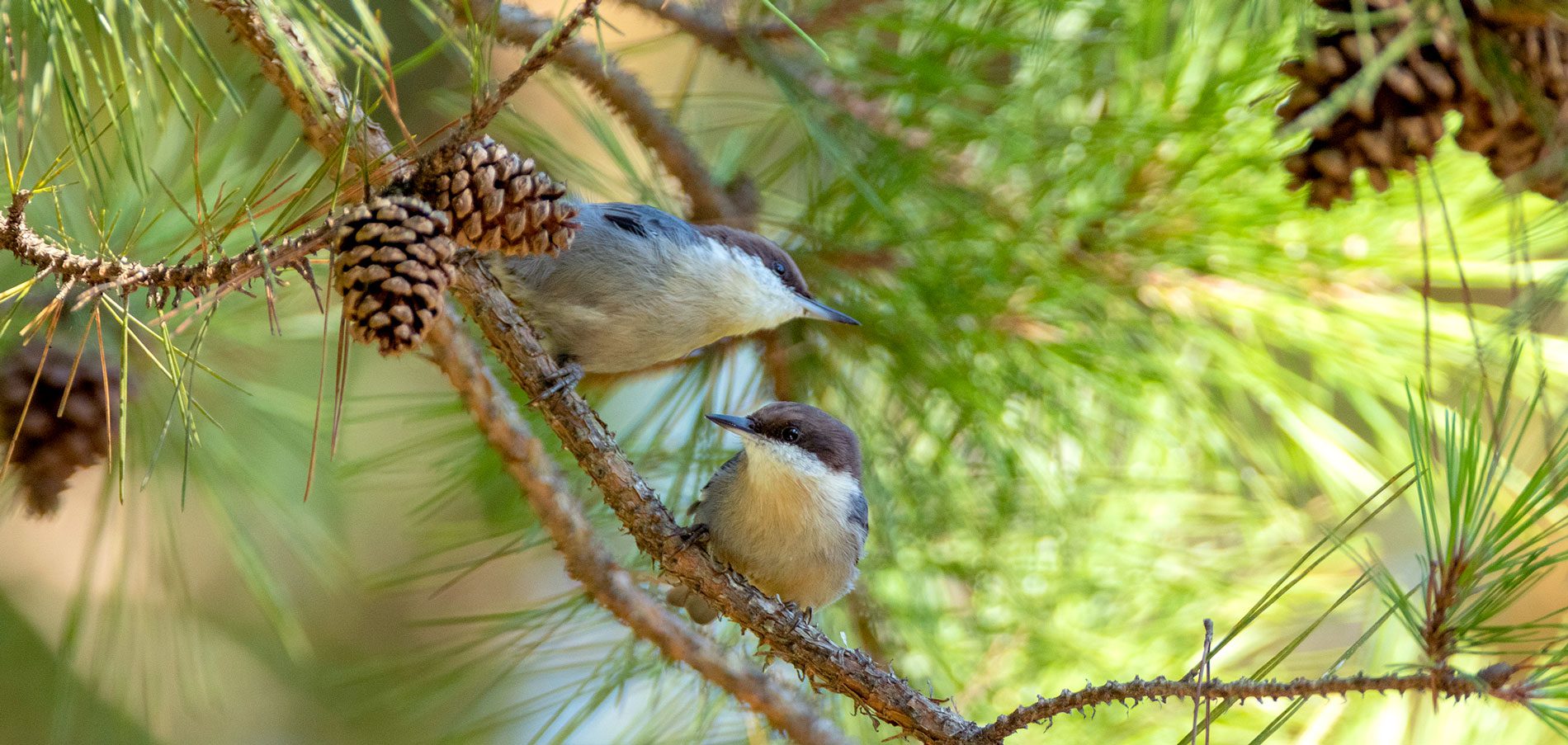
Catch and Release
Through some scouting in the summer of 2020, the researchers identified a source for translocating Brown-headed Nuthatches in the Ouachita National Forest of Arkansas—a strong nuthatch population with good concentrations just south of the Ozarks.
For the capture, scientists crept into a likely woodland opening before dawn, then raised a 6-meter-long mist net on telescoping painter poles. They placed a speaker playing bird calls beneath the net, and for extra effect, perched a hand-painted wooden nuthatch decoy in a nearby branch.
Within minutes, Brown-headed Nuthatches gathered on nearby branches. After a few minutes more, several nuthatches had dived into the net. The biologists carefully lowered the net, untangled the birds, slipped each into a cardboard mailing tube with a perch and netted ends for air, and began placing the tubes in a plastic crate.
In a typical outing, the team trapped nuthatches at three to four sites by midmorning. Then, to avoid warming midday temperatures and minimize the birds’ time in the tubes, the crew sped to a local airport, where they loaded their captives aboard a waiting Missouri Department of Conservation airplane.

Missouri Department of Conservation State Ornithologist Sarah Kendrick readies a decoy to be used in catching Brown-headed Nuthatches in Arkansas for transport to the Ozarks. Photo by Noppadol Paothong/Missouri Department of Conservation. 
Scientists worked fast to capture Brown-headed Nuthatches in Arkansas during the cool early-morning hours, and by noon the birds were transported to Missouri. Photo by Noppadol Paothong/Missouri Department of Conservation.
By noon, the crew and birds arrived at the release site in Mark Twain National Forest, near the small town of Winona. After banding all the birds and putting tiny transmitters on about half, they released the nuthatches into their new home.
Following the reintroductions, scientists began conducting regular resighting surveys to identify birds by their color bands. The goal is to follow the nuthatches’ dispersal in their new habitat and see whether they survive freezing weather and marauding Sharp-shinned and Cooper’s Hawks. In spring 2021, the researchers will monitor nesting success. And then this summer, the process will begin again, as the crew relocates an additional 50 or so nuthatches.
“There are pockets of this open pine throughout the region, so there’s room for them to spread out and move around,” says Kendrick. “All the ones that we’ve gotten our eyes on are actively foraging, they’re exploring the habitat, and that’s exactly what they’re supposed to do. They’re meeting new neighbors and figuring out the lay of the land.”

The team released 46 nuthatches into the Ozarks last year, with plans to release an additional 50 or so birds this year. Photo by Noppadol Paothong/Missouri Department of Conservation. 
About half of the Brown-headed Nuthatches released in the Ozarks carried radio-transmitter backpacks. Photo by Noppadol Paothong/Missouri Department of Conservation.
Meanwhile, foresters continue to thin and burn in the Mark Twain National Forest. Funding under the federal Collaborative Forest Landscape Restoration Program expires this year, but the national forest is working with agency partners to apply for a new grant, in order to create more open woodland and maintain the woodlands that have been restored. Without frequent prescribed fire, the woodlands will once again turn into closed-in forest.
“You’d hate to have invested all this effort and not be able to sustain this,” says Thompson.
Will roughly 100 Brown-headed Nuthatches be enough to establish a breeding population in Missouri’s woodlands? That’s a question Thompson and colleagues will evaluate.
“Do we call it good at that point, or do we look at other potential release sites?” he says. “Those are all questions to be considered down the road based on this first effort.”
A Good Fit for the Ozarks of the Future
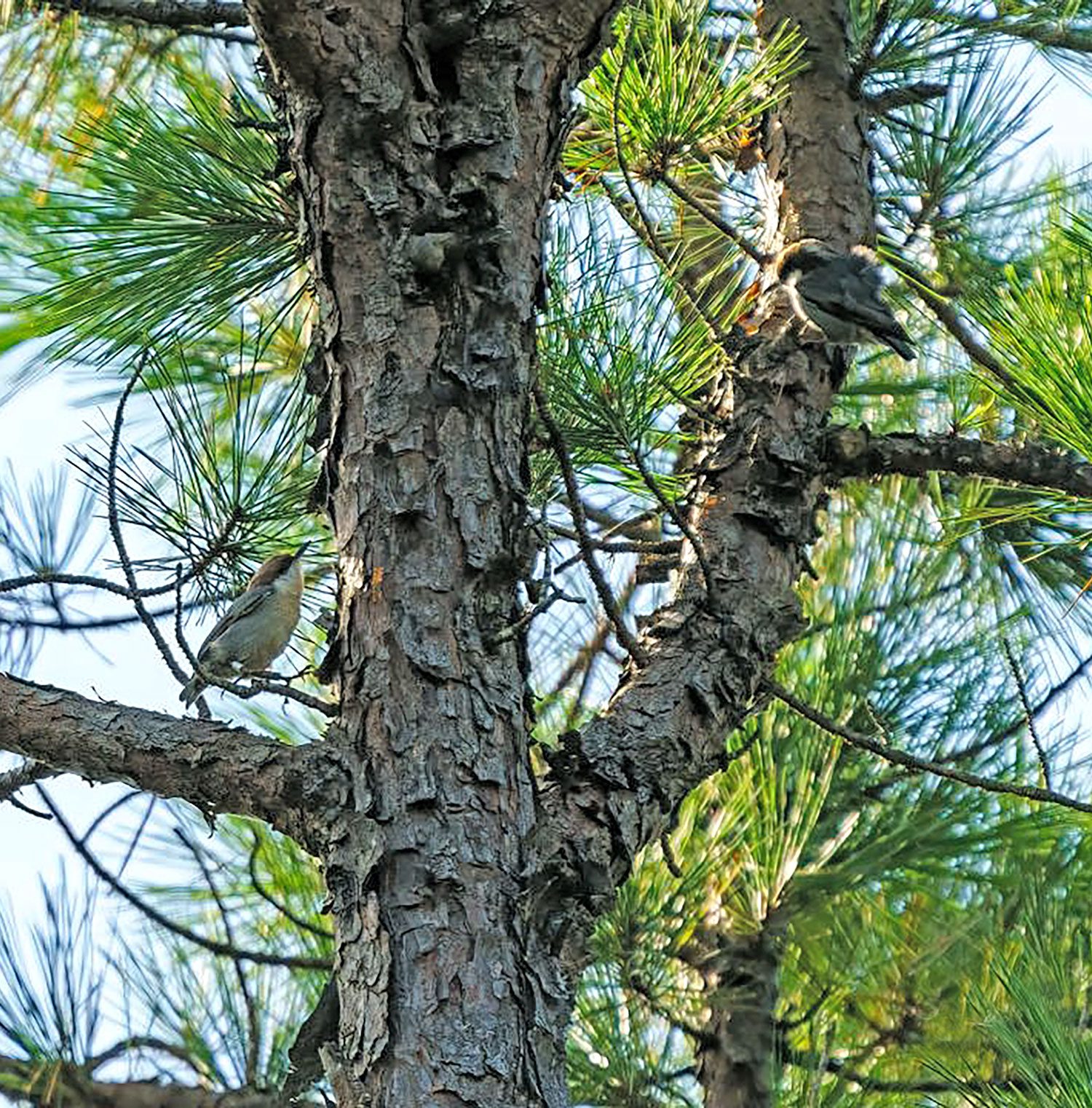
Climate models predict a future climate for southern Missouri that may be warmer and drier overall, with greater stress on vegetation during the growing season.
Pine woodlands, managed with frequent low-intensity fire, are a good fit for that future, says Thompson. And on the basis of its natural history, Brown-headed Nuthatches would be expected to adapt as well.
But only if they can make the leap to new habitat in these more northerly locations. Says Thompson: “We think these ecosystems are moving north, and we know that these are fragmented landscapes and don’t think these birds can follow them.”
That’s why this assisted migration is important to help the species move northward with the shifting climate.
“People sometimes question restoration—should we just be putting back on the landscape what was there 200 years ago?” Thompson says.
But in putting Brown-headed Nuthatches back into southern Missouri’s Ozarks, scientists are achieving both restoration and adaptation—rebuilding the past, while positioning the species for the future.
Freelance writer Greg Breining writes about wildlife, the environment, health, and science. His latest book, Wolf Island, describes the early days of the long-running wolf-moose research study on Isle Royale in Lake Superior.

All About Birds
is a free resource
Available for everyone,
funded by donors like you
American Kestrel by Blair Dudeck / Macaulay Library
